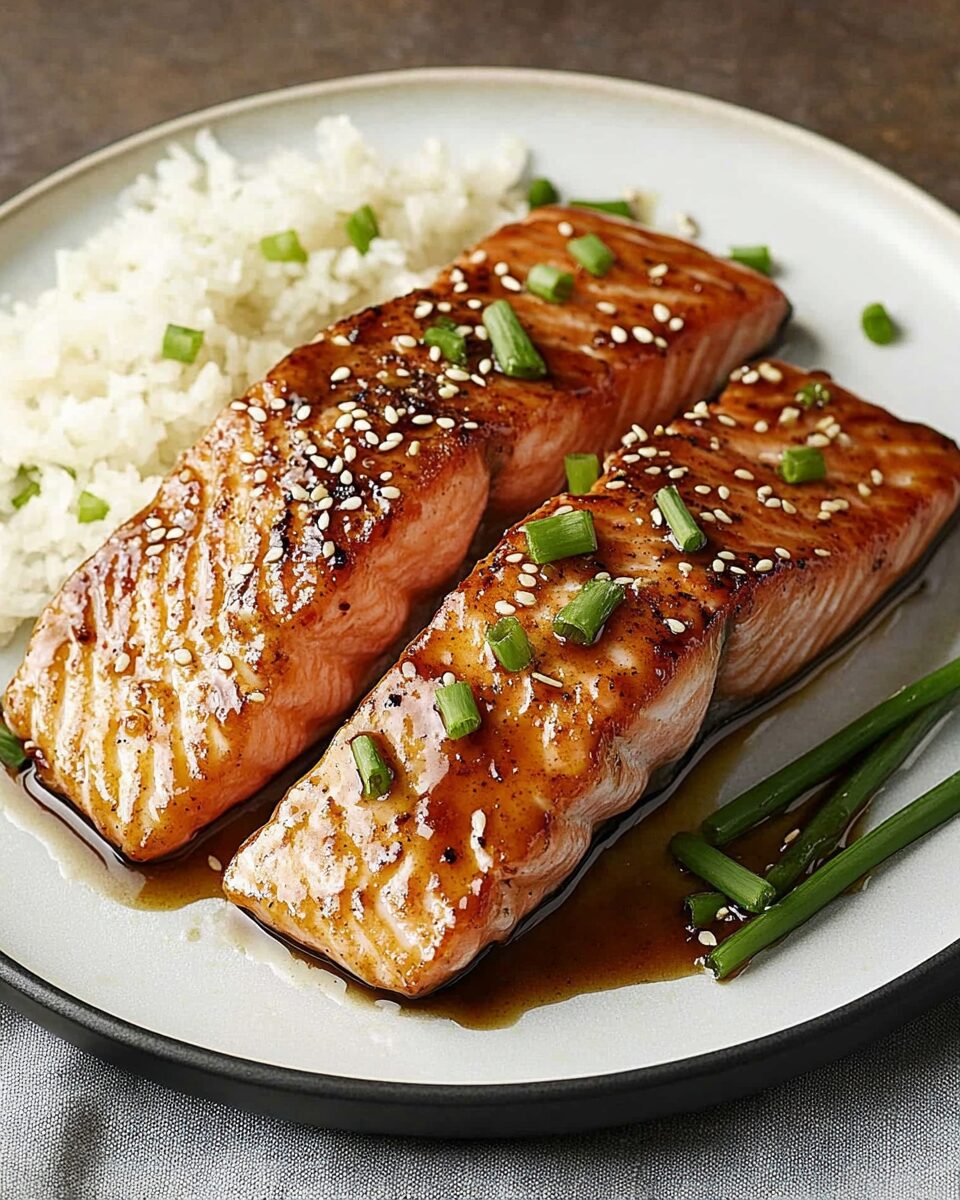A flavorful fusion of sweet and savory, these teriyaki glazed salmon fillets are pan-seared to perfection and finished with a sticky, homemade glaze. Ideal for weeknight dinners or a special occasion, this dish combines rich umami flavor with tender, flaky fish.
FULL RECIPE
Ingredients
- 4 salmon fillets (about 6 oz each), skin-on or skinless
- 1/4 cup low-sodium soy sauce
- 2 tablespoons honey
- 1 tablespoon brown sugar
- 2 tablespoons rice vinegar
- 1 tablespoon sesame oil
- 2 garlic cloves, minced
- 1 teaspoon fresh ginger, grated
- 1 teaspoon cornstarch
- 1 tablespoon water
- 1 tablespoon vegetable oil (for searing)
- Sesame seeds, for garnish (optional)
- Sliced green onions, for garnish (optional)
Directions
- In a small saucepan, combine soy sauce, honey, brown sugar, rice vinegar, sesame oil, garlic, and ginger over medium heat.
- In a separate small bowl, mix cornstarch and water to create a slurry.
- Once the sauce begins to simmer, stir in the slurry and cook for 1–2 minutes until the glaze thickens. Remove from heat and set aside.
- Pat salmon fillets dry and season lightly with salt if desired.
- Heat vegetable oil in a skillet over medium-high heat.
- Place salmon fillets skin-side down (if applicable) and sear for 3–4 minutes until browned.
- Flip and cook for another 3–4 minutes or until salmon is cooked through and flakes easily with a fork.
- Spoon teriyaki glaze over each fillet in the last minute of cooking.
- Remove from heat, plate, and drizzle with extra glaze. Garnish with sesame seeds and green onions if desired.
Nutritional Information
- Calories: 350
- Protein: 30g
- Fat: 18g
- Saturated Fat: 3g
- Carbohydrates: 15g
- Sugar: 11g
- Sodium: 600mg
- Fiber: <1g
Health Benefits of Salmon
Salmon is widely recognized as one of the healthiest protein sources available. It’s rich in omega-3 fatty acids, particularly EPA and DHA, which support cardiovascular health, brain function, and inflammation control. Regular consumption of salmon can help reduce the risk of heart disease, improve cognitive health, and support joint health, making it an ideal main ingredient in a balanced diet.
The Appeal of Teriyaki Flavor
Teriyaki is a classic Japanese flavor profile that blends sweet, savory, and umami tastes. The glaze typically includes soy sauce, sugar, and mirin or vinegar, producing a rich, sticky coating that enhances the natural flavors of the salmon. Its universal appeal makes it a family-friendly option that suits a wide variety of palates.
Versatility of Teriyaki Salmon
Teriyaki glazed salmon is an incredibly versatile dish. It pairs well with a broad range of side dishes including rice, quinoa, noodles, steamed vegetables, or salads. The glaze can also be used on other proteins such as chicken or tofu, making it a multipurpose component for home cooks.
Cooking Methods for Salmon
While this recipe uses pan-searing as the main cooking method, teriyaki glazed salmon can also be baked, grilled, or air-fried. Each method brings a slightly different texture and flavor, allowing for customization based on preference or kitchen equipment availability.
Pairing Suggestions
Complementary sides for teriyaki salmon include jasmine rice, stir-fried vegetables, sesame noodles, or a crisp Asian slaw. For a lighter meal, pairing it with a cucumber salad or miso soup can offer a well-rounded and refreshing experience.
Sauce Customization Tips
The teriyaki glaze in this recipe can be easily adjusted to taste. For a spicier profile, adding chili flakes or sriracha works well. For more sweetness, increasing the honey or brown sugar slightly can intensify the flavor without overwhelming the dish.
Storing and Reheating Leftovers
Leftover teriyaki salmon can be stored in an airtight container in the refrigerator for up to three days. It reheats well in the microwave or on the stovetop over low heat. To maintain moisture, add a splash of water or extra glaze before reheating.
Make-Ahead Preparation
You can prepare the teriyaki sauce ahead of time and store it in the refrigerator for up to a week. This makes assembling the meal much quicker, especially on busy weeknights. The salmon can also be marinated briefly in the glaze for deeper flavor.
Nutritional Highlights
Aside from omega-3s, salmon is rich in high-quality protein, B vitamins, selenium, and potassium. The glaze, while slightly sweet, contributes antioxidants from garlic and ginger, both of which are known for their anti-inflammatory properties.
Gluten-Free Options
For a gluten-free version of this dish, substitute the soy sauce with tamari or coconut aminos. These alternatives provide similar umami richness without the gluten, making the recipe suitable for those with dietary restrictions.
Sustainability Considerations
When buying salmon, consider sourcing it from sustainable fisheries. Look for certifications such as MSC (Marine Stewardship Council) or opt for responsibly farmed salmon to support environmentally conscious seafood consumption.
Cultural Significance of Teriyaki
Teriyaki is rooted in Japanese culinary tradition, dating back centuries. It refers not only to the sauce but also to the cooking method involving broiling or grilling with a shiny glaze. Bringing this element into a home-cooked meal celebrates global food culture and encourages exploration of international flavors.
Kid-Friendly Aspects
The sweet and savory taste of teriyaki makes this recipe particularly appealing to children. Its mild flavor and tender texture are accessible to younger eaters, and it’s a great way to introduce seafood into their diets.
Dinner Party Presentation
Teriyaki glazed salmon fillets make a visually appealing main course for gatherings. The glossy sauce, garnished with sesame seeds and green onions, provides a restaurant-quality look without requiring advanced cooking skills.
Meal Prep and Batch Cooking
This recipe is great for meal prep. Cook multiple salmon fillets at once and portion them with sides in containers for balanced lunches or dinners throughout the week. The flavors hold up well over time and the glaze keeps the fish moist.
Flavor Balancing Tips
Achieving the right balance of sweetness, saltiness, and acidity is key to the success of teriyaki sauce. Tasting as you cook and making minor adjustments ensures a well-rounded flavor that complements the richness of the salmon.
Ideal Cooking Temperatures
Salmon should be cooked to an internal temperature of 125°F to 130°F for medium doneness. Overcooking can dry out the fillets, while undercooking may result in an unpleasant texture. A meat thermometer helps ensure consistency.
Presentation Enhancements
Garnishing the salmon with sesame seeds, green onions, or a wedge of lime not only adds color but enhances the overall flavor. A well-presented dish is more appetizing and elevates the dining experience even at home.
Serving Suggestions for Different Occasions
For casual family dinners, serve with steamed rice and vegetables. For a more formal dinner, plate the salmon with wild rice, grilled asparagus, and a drizzle of extra glaze. The dish adapts well to different atmospheres.
Conclusion
Sweet and savory teriyaki glazed salmon fillets offer a perfect balance of nutrition, flavor, and simplicity. Whether you’re preparing a healthy meal for your family, hosting guests, or meal prepping for the week, this recipe delivers on all fronts. Its versatility, cultural richness, and accessibility make it a standout option that will remain a staple in your recipe collection. From the tender salmon to the glossy glaze, every bite reflects thoughtful preparation and delicious satisfaction.






